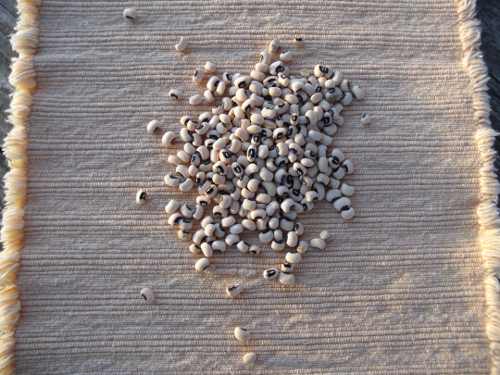- Lake County News Reports
- Posted On
The Veggie Girl: Health and luck with black-eyed peas

Happy New Year and pass the black-eyed peas, please!
These happy little bi-colored legumes, also called cowpeas, field peas, crowder peas or Southern peas, are said to bring good luck in the New Year.
When combined with leafy vegetables such as collards or kale, which represent the green of money, then a financial boon is said to be in store.
Black-eyed peas are actually one of four recognized cultivated subspecies of the cowpea, a crop prevalent in Africa.
Ancient ancestors were inconspicuous, low-lying plants that grew among dusty rocks in the Sahel of north central Africa, a transitional region that lies between the Sahara desert to the north and savannahs to the south.
Cowpeas have been cultivated throughout the African continent for thousands of years and are an important resource there, both as a staple food and a source of revenue for countless people that work small farms.
Two hundred million men, women and children in Africa consume cowpeas often, even daily when they’re available. Africa’s hot, arid climate is a perfect environment for this crop, which thrives in such conditions.
Cowpeas, black-eyed peas and the like are the dried seeds of long, slender green pods that look much like one of their relatives, Asian yardlong beans. The seeds are pea-like, on the small side when compared to other dried beans. This, along with the characteristic black spot on the center of each bean, provides the source of their moniker.
After centuries of cultivation in Africa, cowpeas became popular in many regions of Asia. They were brought across the Atlantic to the Caribbean basin in the holds of slave ships in the 17th century. There are records of their use in Jamaica as early as 1675, in Florida by 1700, and in North Carolina by 1714.
These plants were long considered “poor man’s food” and looked upon as cattle fodder by those with land throughout the Eastern seaboard, who preferred the English pea. George Washington, for example, imported 40 bushels of seed from Jamaica to plant for his livestock in 1797.
Farmers in the southern U.S., however, embraced the black-eyed pea as a food source. It grew well in the heat of the south, unlike the cool weather English pea.
Many varieties were developed, some known only within a particular region. One such variety was the Clay pea carried by Confederate soldiers as a source of protein. Many who reenact the history of the Civil War grow the Clay pea to provide an authentic field provision.
Hoppin’ John, a favorite southern dish made with black-eyed peas and greens (often collards), is traditionally served there on New Year’s Day as a harbinger of luck and prosperity. Southerners are not the only ones who see black-eyed peas as being lucky, however.
They’re eaten by Sephardic and Israeli Jews on Rosh Hashana, the Jewish New Year, as a good luck tradition. This practice is recorded in the Babylonian Talmud, compiled in 500 A.D., which says, "… now that you have established that good-luck symbols avail, you should make it a habit to see qara (bottle gourd), rubiya (black-eyed peas), kartei (leeks), silka (either beets or spinach), and tamrei (dates) on your table on the New Year."
Sephardic Jews immigrated to Georgia in the 1730s and have lived there continuously since. Some say their custom of eating black-eyed peas at the New Year was adopted by non-Jews in the South. Others point to the Civil War, when the town of Vicksburg, Mississippi ran out of food. A store of black-eyed peas was found, and they’ve been considered lucky ever since.
A variety of dishes around the world are made with black-eyed peas, including Texas caviar, which is made by marinating them for a relish-like salad.
Fritters are made from them in Colombia; they’re mashed and fried to make akkra in West Africa and the Caribbean; in Indonesia they’re used for curry dishes; they’re made into a stew called daal in northern India and Pakistan; in Vietnam they’re used in a dessert with sticky rice and coconut milk; and in Portugal, they’re served as a side dish with boiled cod and potatoes, just to name a few uses in world cuisine.
The tender leaves of the plant are nutritious as well; they contain high stores of good quality protein. In fact, NASA is so impressed with the nutritional potential of the leaves that they’ve considered growing cowpeas in future space stations as food for astronauts.
In some areas of Africa, cowpeas are cooked as green pods, and the swollen beans consumed. These fresh cowpea pods, together with fresh green leaves, are the earliest foods available to harvest, another reason they’re a live-saving crop there.
When planted, the cowpea family gives copious amounts of nitrogen to the soil, which makes them a wonderful crop to plant in advance of vegetables that use much of it, such as corn.
These small beans are amazingly nutritious, with 25 percent of calories in the form of protein. They’re also rich in digestible carbohydrate. When combined with grain, a meal with balanced protein is achieved, which makes the southern tradition of serving them with cornbread all the more appealing.
Today’s recipe is – of course! – my version of Hoppin’ John. Be sure to serve it with plenty of cornbread.
If you don’t have time to soak the beans overnight, put them in a pot with the water, bring it to a boil, then turn off the heat and let the beans sit for an hour. Drain the water and cook as directed below. You can also substitute frozen or canned peas.
If desired, add a ham hock to the pot with the beans as you cook them.
Enjoy! And best wishes for a happy, healthy 2012.
Hoppin’ John
2 cups dried black-eyed peas
6 cups water
1 medium white or yellow onion, chopped
Several sprigs fresh thyme (tied with kitchen string for use as a bouquet garni or the chopped leaves of the sprigs)
2 bay leaves
1 medium green or red bell pepper, seeded and chopped
1 large bunch kale, stems removed and chopped
1 cup long-grain rice
2 medium cloves garlic, minced
1 tablespoon smoked paprika
Leaves from 3 or 4 sprigs thyme leaves (1 tablespoon; may substitute 1 teaspoon dried thyme)
Salt & freshly ground black pepper to taste
Tabasco sauce (optional)
Rinse black-eyed peas and soak in water to cover for six hours or overnight. Drain peas and transfer to a large soup pot.
Add water, onions, kale, garlic, thyme, and bay leaves. Simmer until beans are tender but still whole, about 45 minutes.
Add rice, green or red pepper, paprika, salt, and pepper. Cover and simmer until rice is tender, about 15 to 20 minutes.
If desired, season with Tabasco sauce. Remove thyme (if in bouquet garni) and bay leaves before serving. Ladle into bowls and enjoy with cornbread.
Makes four servings.
Recipe by Esther Oertel.
Esther Oertel, a freelance writer, cooking teacher, and speaker, is passionate about local produce and all foods in the vegetable kingdom. She welcomes your questions and comments and may be reached at This email address is being protected from spambots. You need JavaScript enabled to view it..
Follow Lake County News on Twitter at http://twitter.com/LakeCoNews, on Tumblr at www.lakeconews.tumblr.com, on Google+, on Facebook at www.facebook.com/pages/Lake-County-News/143156775604?ref=mf and on YouTube at www.youtube.com/user/LakeCoNews .













